
Zhongshan Bridge in Lanzhou, commonly known as Zhongshan Iron Bridge and Yellow River Iron Bridge, is located under the Baita Mountain in the middle section of Binhe Road, Lanzhou City, Gansu Province. Opened to traffic in 1909, it was the first bridge in real sense on the long Yellow River and was reputed as "No. 1 Bridge over the Yellow River". Zhongshan Bridge has 4 piers and 5 spans over a length of 234m and a width of 7.5m. It is a typical steel structure on which the bridge body is a riveted steel truss structure with simple support, with a steel frame arched girder over it. In 2006, this century-old bridge was included by Natural Cultural Heritage Administration in the sixth batch of national key cultural relics protection units.
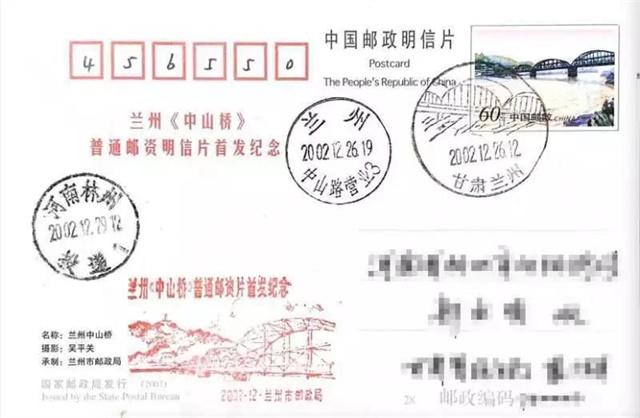
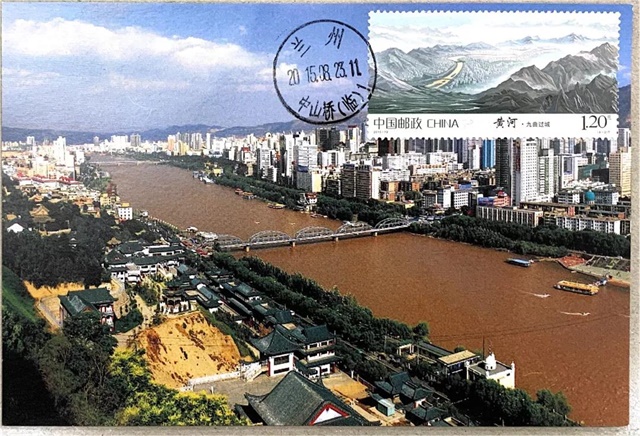
Steel Structure Museum collects two types of postcards themed "Zhongshan Bridge". One was issued by State Post Bureau in 2002. This postcard, No. 2002 (2800)-0096, has a close-up of Zhongshan Bridge on the front and a 60-cents tamp of the same theme on the back, attached with the postmark of "Commemorative Debut of Regular Stamped Lanzhou Zhongshan Bridge Postcard" and the posted postmark; the other type is printed with the landscape of Lanzhou City on the front, pasted with a 120-cent stamp of "Zigzag Yellow River Passing the City", and postmarked. Today, let's learn the story behind this famous steel bridge from these two postcards.
One Bridge Flying Across North and South: the Construction History of An Iron Bridge over the Yellow River
Lanzhou is an important town on the "Silk Road". However, due to the obstruction of the Yellow River, it was internally and externally inaccessible. Building a fixed bridge over the Yellow River was a long-cherished wish of the people of Lanzhou.
From the fifth year of the reign of Emperor Hongwu in the Ming Dynasty (1372 AD), the local government began to build a floating bridge over the Yellow River and named it "Zhenyuan Bridge". The bridge was relocated three times until it was settled to where Zhongshan Bridge is now situated in the reign of the eighteenth year of Emperor Hongwu (1385 AD)-under the Baita Mountain. The Yellow River floating bridge was lined with 24 large ships over the Yellow River at a distance of 5m, connected by long wood, paved with plates, and fenced; 4 vertical iron columns were erected on both sides of the north and south, with 45 large wooden columns to anchor the ships on the river through two thick iron ropes, each 50m long. In winter, the floating bridge would be removed when the Yellow River was frozen; in spring, it would be re-erected when the ice melted. This floating bridged was depicted in the verses that "Look at the frozen peach blossom in March, And green willows by the bridge over the melting river"; "taming the flood dragon", one of the eight ancient sights in Lanzhou, was about this floating bridge.
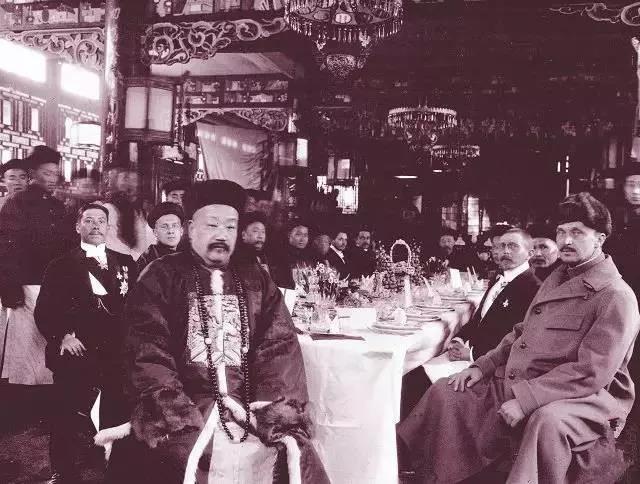
In spite of its role in "controlling the main road hub and connecting the Western Regions", the demolition in winter and re-erection in spring of the Yellow River floating bridge became a waste of manpower and money. At the same time, traffic remained a problem when the floating bridge was broken by floods from time to time during the flood season of the Yellow River. During the reign of Emperor Guangxu in the Qing Dynasty, Zuo Zongtang, Governor of Shaanxi and Gansu, tried to build the Yellow River Iron Bridge, but in vain because of the excessively high price charged by foreign contractors and a lack of funds. In 1906, Sheng Yun, then Governor of Shaanxi and Gansu, Peng Yingjia, inspector of Lanzhou, happened to meet Keyos, manager of Telge&Schroeter from Germany, when the Westernization Movement was in full swing. Keyos offered a bid that was only one third of the price that Zuo Zongtang was charged. In May, the bridge construction proposal was approved by the government of the Qing Dynasty. When the contract was signed in October, the two parties agreed that Telge&Schroeter be the contractor of Yellow River Iron Bridge in Lanzhou. The construction period was 18 months, and the total price was 165,000 in silver, paid in 4 installments; steel, cement, and plates were imported from Germany; the style, structure, load and other parameters were all constructed to meet foreign superior standards. The warranty period of the bridge was 80 years.
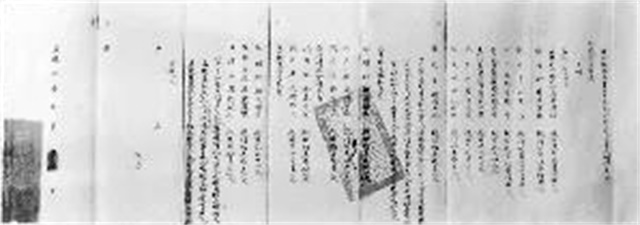
After year-long transportation of building materials and repeated negotiations and communications, the construction was officially commenced in the spring of 1908. At that time, the contractor built a boiler room on the south bank of the Yellow River and erected steel cables to tow engineering ships on both sides of Zhenyuan Floating Bridge. The floating bridge became a channel for transporting engineering materials and the working of craftsmen. Piers were built from the south side to the north side in the south of the river and in the middle. The upper steel truss structures were installed on the piers from south to north. The middle of the bridge deck was a driveway, while the two sides were sidewalks fenced by steel pipe guardrails on both sides. During the construction process, the contractor engaged a new American engineer named Man Baoben, but fortunately this did not cause a negative impact.
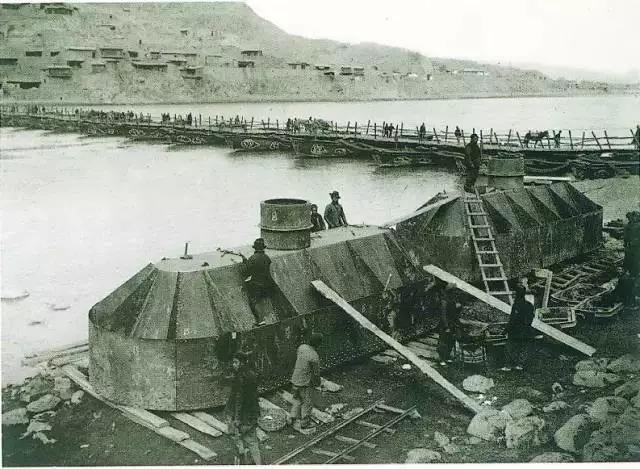
On August 19, 1909, the iron bridge was officially opened to traffic. A three-bay plague holder was built on each of the north and south of the iron bridge to hang four celebrity plaques: two plagues that read "No. 1 Bridge" inscribed by Sheng Yun, located at the bridge heads in the north and south; plagues that read "Calm River" and "Trilateral Benefits". The couplets were "Once Making Waves like Sea, Now Calm under the No. 1 Bridge" and "A Natural Barrier Tamed to Good Thoroughfare Leading to the River City to Guard Peace, A Turbulent River Turned into Picturesque Sight with Aerial Ladder Viewed in This Light". Due to the high transportation costs, the iron bridge construction actually consumed 306,600 in silver, nearly doubling the original budget. However, it was still praised as "the most frugal project" by Ye Gongchuo, who later served as the traffic chief of the government of the Republic of China.
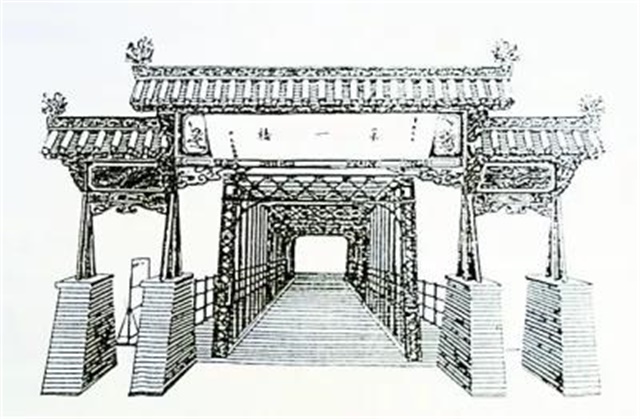
Tremendous Changes: A Bridge that Survived Vicissitudes for A Century
The century-old Zhongshan Bridge has witnessed major historical changes in modern China. When the Revolution of 1911 broke out, provinces became independent, but Gansu Province, located on the northwestern frontier, remained loyal to the incompetent and corrupt Qing Dynasty. Peng Yingjia, as a hero of bridge building, tried to mend the case with Chang Geng, the last governor of Shaanxi and Gansu, at first. Finally, unable to resist the unstoppable historical trend, Gansu sent a telegram, declaring its support to the Republic in 3 days after the Emperor abdicated. Peng Yingjia returned to Beijing from Lanzhou in 1912 and had disappeared since then.
During the period of the Republic of China, the Yellow River Iron Bridge played an important role in facilitating the urban and rural construction and municipal administration in Lanzhou and in connecting the city with Qinghai, Xinjiang, and Ningxia. A large number of commercial goods and materials were transported across the country through the bridge.
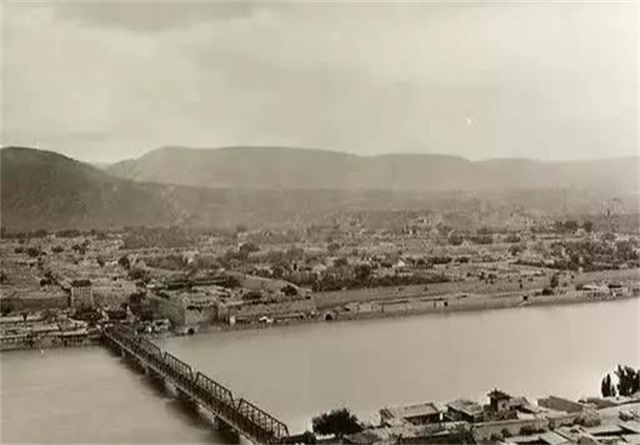
After the outbreak of the Anti-Japanese War, Lanzhou was not only a rear area and a transit station to receive international aid, but also one of the training centers of the Chinese Air Force. This made it a hard target to the Japanese army, and Zhongshan Bridge was also an important target for bombing. In the air battle of Lanzhou in February 1939, the Chinese Air Force won a brilliant victory that killed 63 enemy pilots and brought down 15 enemy aircraft without any manpower or aircraft loss, which greatly inspired the morale of people all over the country. At the same time, this iron bridge provided an easy channel for camel teams and cars to transport military resources continuously to the front line of the war and made an indelible contribution to the victory.
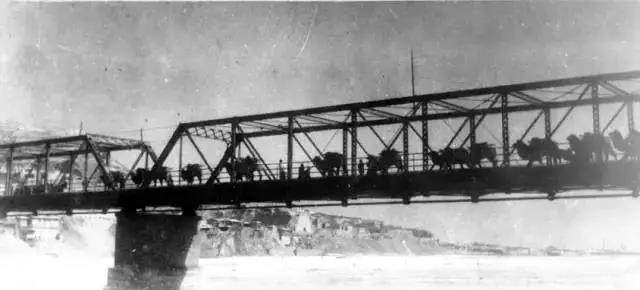
On August 26, 1949, during the battle of the People's Liberation Army to liberate Lanzhou, Zhongshan Bridge was damaged as two cars loaded with ammunition from the Kuomintang exploded. After emergency repair that lasted for ten days and ten nights, Zhongshan Bridge was reopened to traffic on September 6. The People's Liberation Army marched into Hexi and Xinjiang and accelerated the liberation of the entire northwest region.
Why the Name Zhongshan: Controversy over the Time of Name Change
On June 1, 1929, the National Government held a funeral for Mr. Sun Yat-sen in Nanjing and called it the "Final Integration of Ritual and Political Control under the Kuomintang Leadership". Before and after this event, name changes occurred all over the country in order to commemorate Mr. Sun Yat-sen (Zhongshan). In Lanzhou, the National Army led by Feng Yuxiang, who ruled Gansu, also followed this trend and changed names of places in the city for commemorative purposes, including Zhongshan Bridge, Zhongshan Road, Zhongshan Forest, and Zhongshan Memorial Hall.
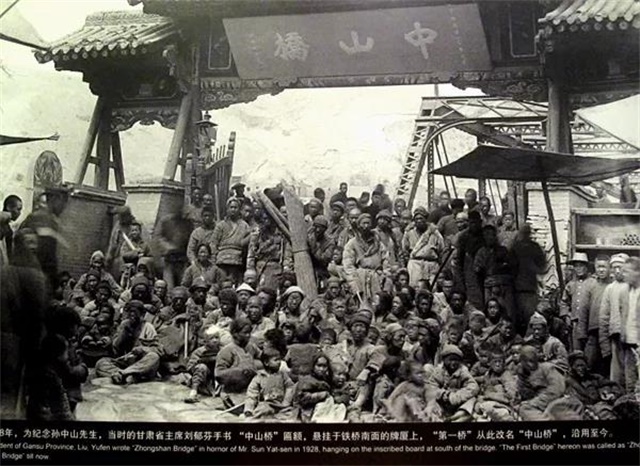
About when the Yellow River Iron Bridgewas renamed as Zhongshan Bridge in Lanzhou, some think that it was during the Anti-Japanese War in the early 1940s, commonly believed in 1942. However, others think that the change occurred before 1928. A precious photo named "Famine victims begging in Zhongshan Bridge in Lanzhou" collected in the Gansu Provincial Archives showed two lines of characters in running script that read "May in the 17th Year of the Republic of China" and "Liu Yufen in Qingyuan", as well as an affixed name seal in addition to the name "Zhongshan Bridge" in big Chinese characters of Wei calligraphy style on the rectangular plaque hung on the plague holder before the bridge. It is presumed that the name of the bridge ought to be inscribed by Liu Yufen, then Chairman of Gansu Province. The bridge was renamed Zhongshan Bridge at least in 1928. The exact time for the name change needs to be confirmed after further probing into relevant historical materials.
Why So Rock-Solid: Maintenance and Repair of Zhongshan Bridge
Over the past 100 years, Zhongshan Bridge has withstood floods, erosion by elements, collision of vehicles and ships, and two large-scale wars. In spite of being weather-beaten, it still stands towering and bears the important responsibility of connecting the banks of the Yellow River. Its ability to remain majestic after a century is credited to the engineering quality and the commitment to contract of the German contractor and more to the consistent care and protection by the people of Lanzhou.
After the iron bridge was open to traffic in 1909, in order to protect it effectively, the local government promulgated regulations on managing the iron bridge and its repairs over ages, as well as the rules for patrol guards and passage of vehicles, horses and pedestrians. The regulations on managing the iron bridge and its repairs over ages consisted of 10 articles that detailed the rules and specific methods for routine maintenance and repair of the iron bridge. In 1910, a ban was issued specifically against horse riding on the iron bridge.
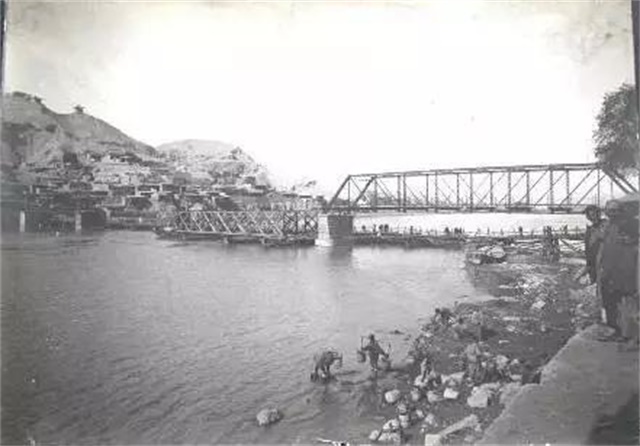
Since 1931, Zhongshan Bridge has undergone 18 repairs. The repairs or emergency maintenance before 1949 were mostly stopgap rather than systematic and failed to fundamentally increase the original carriage load to the level of passing vehicles. After the founding of New China, Zhongshan Bridge underwent five times of consolidation and maintenance. In particular, in addition to the comprehensive maintenance and consolidation and based on the opinions of Soviet experts, five steel frame arch beams were added on the upper end of the original parallel chord and the original wooden deck was totally replaced by iron plates in 1954. That's how Zhongshan Bridge looks now.
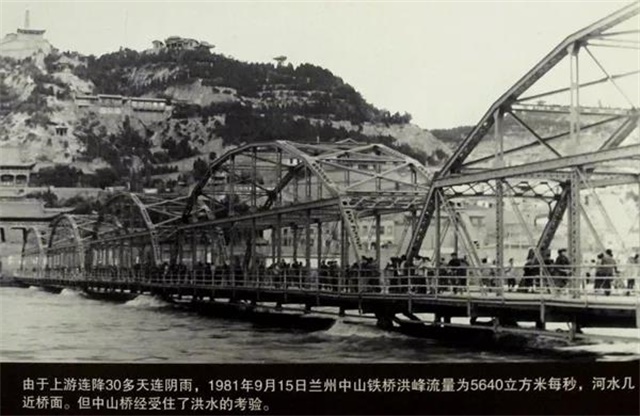
In 1989, a water supply vessel weighing 260 tons lost control and hit the bridge piers, causing a serious damage to Zhongshan Bridge. Lanzhou Municipal Government immediately mobilized technical forces for emergency repairs and finally saved the iron bridge. In the same year, the German contractor sent a letter to the Lanzhou Municipal Government, declaring expiration of the contract while inquiring about the status of the iron bridge. In 2004, Zhongshan Bridge was officially changed to a pedestrian bridge, bidding farewell to nearly a century-old traffic history.

In order to meet the navigation clearance requirement, Zhongshan Bridge was subject to the last overhaul in 2011. The overhaul improved the seismic and flood resistance performance of the bridge, strengthened the piers, and raised the bridge deck by 1.2m. After the project was completed, this century-old bridge would sustain for another 50 years reliably.
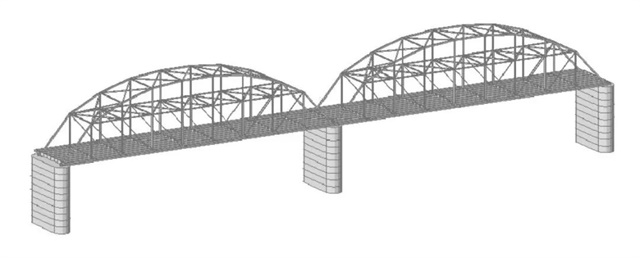
So far, more than 10 beautiful and advanced bridges have been built in Lanzhou City. This ancient iron bridge on the Yellow River is no longer the only channel connecting the north and south banks of the Yellow River. However, people still respect it as before. "Look up to the White Tower, Cross the Yellow River Slowly. Two mountains confront each other silently on the other side of the river, ships navigate in bustling traffic in the middle." This century-old iron bridge is like an epic, engraved with the vicissitudes of the people by the Yellow River and telling stories about the historical changes of Lanzhou City.